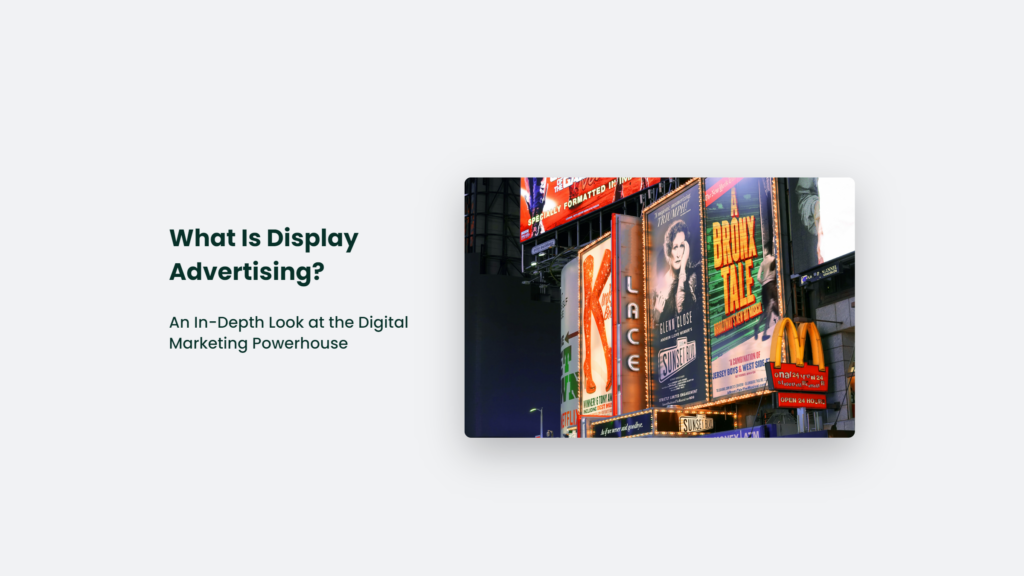

What Is Display Advertising? An In-Depth Look at the Digital Marketing Powerhouse

As Seen On
In the ever-evolving digital world, the query ‘What is display advertising?’ opens the door to a realm where creativity meets technology. This intriguing intersection is not just about understanding a concept; it’s about exploring a dynamic and multifaceted marketing strategy. Join us as we delve deeper into display advertising, uncovering its nuances and discovering its profound impact on the digital marketing landscape.

What is Display Advertising?
Display advertising, a cornerstone of digital marketing, is a visual-based form of online advertising where banners, videos, images, and other graphical elements are used to promote products or services across various digital platforms. This multifaceted approach is designed to capture user attention and drive action, making it an essential tool for modern marketers.
The Evolution and Importance of Display Advertising
Display advertising has become more crucial in the rapidly evolving digital landscape. In 2023, U.S. companies are estimated to spend around $37.36 billion on display advertising, a testament to its growing popularity. Despite challenges like ad blocker technology, which causes significant revenue losses, some companies have achieved staggering ROIs, with reports of returns as high as 486 per cent from single campaigns. It highlights the effectiveness of display ads in attracting qualified leads and driving conversions.
Display Advertising: A Symphony of Creativity and Strategy
A successful display ad campaign harmonizes creativity with strategic planning. Key steps include:
- Defining your audience.
- Setting clear campaign goals.
- Ensuring your ads are correctly sized for various platforms.
- Monitoring vital metrics like acquisition and click-through rates.
This approach ensures that your message resonates with the right people, ultimately enhancing the impact and ROI of your advertising efforts.
The Power of Visuals in Display Advertising:
The Power of Visuals in Display Advertising is a critical aspect that significantly influences the effectiveness and success of online marketing campaigns. Here’s a deeper look into why visuals are so impactful in display advertising:
The Psychological Impact of Visuals
- Rapid Processing: The human brain processes images 60,000 times faster than text. This instant comprehension makes visuals an incredibly efficient way to communicate a message or value proposition.
- Emotional Connection: Visuals have the power to evoke emotions, which plays a crucial role in consumer decision-making. A compelling image can create a lasting impression and drive consumer engagement.
Enhancing Brand Recall and Recognition
- Memorability: Visual content, especially when unique and high-quality, is more likely to be remembered than text-based content. It aids in brand recall and recognition, which is crucial for long-term customer relationships.
- Brand Identity: Consistent use of specific colours, imagery, and design elements in display ads helps establish and reinforce brand identity. This consistency ensures your audience can instantly recognize your brand across various platforms.
Increasing Engagement and Interaction
- Attention-grabbing: In the cluttered space of digital advertising, a visually appealing ad can grab the audience’s attention more effectively than text-heavy ads.
- Interactivity with Rich Media: Rich media ads that include videos, GIFs, and interactive elements can significantly increase user engagement. These ads are not only attention-grabbing but also provide an immersive experience.
Conveying Information Efficiently
- Quick Message Delivery: Visuals can convey complex messages quickly and effectively, an essential factor in display advertising where user attention span is limited.
- Cross-Cultural Appeal: Visuals can transcend language barriers, making them effective for global campaigns. A well-designed image can be universally understood, broadening the potential reach of an ad.
Supporting Conversion Goals
- Direct Influence on Buying Decisions: Effective visuals can directly impact consumer purchasing decisions. A compelling image or video can entice users to click through and explore a product or service further.
- Optimizing for Conversion: Ad visual elements should be optimized for conversion, with clear and prominent calls-to-action (CTAs) that guide users on what to do next.
Visual Content Marketing Statistics
- Increased Engagement: Content with visuals gets 2.3 times more engagement on platforms like Facebook.
- Improved Conversion Rates: Conversion increases by 86% when videos are used on a landing page.
The Role of Aesthetics and Design
- Quality and Aesthetic Appeal: The quality of visuals in ads reflects the brand’s perceived value and professionalism. High-quality, aesthetically pleasing images are more likely to be associated with trustworthiness and quality.
- Adaptability to Different Formats: Adapting visual designs to suit different ad formats and sizes while maintaining aesthetic appeal is crucial in display advertising.

The Versatility of Display Advertising:
The versatility of display advertising lies in its ability to adapt to various marketing goals, audience segments, and digital environments. This flexibility makes it an invaluable tool for marketers seeking to effectively reach and engage their target audiences. Let’s explore the various aspects that contribute to the versatility of display advertising:
Wide Range of Formats and Designs
- Diverse Ad Formats: Display advertising encompasses a variety of formats, including static banners, rich media ads, video ads, and interactive ads. Each format serves different purposes and caters to different audience preferences.
- Creative Freedom: Advertisers can design ads that align with their brand identity and campaign objectives. It could range from simple, text-based designs to complex, interactive multimedia ads.
Targeting and Personalisation
- Advanced Targeting Options: Display advertising platforms offer sophisticated targeting options, such as demographic targeting, interest targeting, and behavior-based targeting. It allows advertisers to reach specific segments of their audience with tailored messages.
- Personalization Capabilities: With technologies like dynamic creative optimization, ads can be personalized in real-time based on user data, making them more relevant and effective.
Integration with Multiple Platforms and Devices
- Cross-Platform Compatibility: Display ads can be served across various digital platforms, including websites, social media, mobile apps, and video platforms. This cross-platform reach ensures that ads can engage users wherever they spend their time online.
- Responsive Design: Ads can be designed to be responsive, ensuring they are effectively displayed across different devices, from desktops to smartphones, enhancing user experience and engagement.
Complementing Other Marketing Channels
- Multi-Channel Strategy: Display advertising works well with other digital marketing channels like search engine marketing, email marketing, and social media marketing. It helps create a cohesive and comprehensive marketing strategy.
- Supporting the Customer Journey: Display ads can be used at different stages of the customer journey, from raising brand awareness to driving conversions and retargeting.
Measurable and Optimizable
- Data-Driven Insights: The effectiveness of display ads can be measured using metrics such as click-through rates, conversion rates, and return on ad spend. This data allows for continuous optimization of campaigns for better performance.
- Testing and Optimization: The versatility of display advertising also lies in the ability to test different ad elements (like copy, design, and CTAs) and optimize based on performance data.
Evolving with Technology and Trends
- Adaptation to New Technologies: Display advertising continuously evolves with new technologies, such as augmented reality and programmatic advertising, keeping the medium fresh and effective.
- Responsive to Market Trends: Display ads can quickly adapt to changing market trends and consumer preferences, making them a dynamic tool for contemporary marketing strategies.
Trends and Innovations in Display Advertising
As the digital marketing landscape evolves, so do display advertising strategies. One emerging trend is the growing popularity of native advertising, which is more integrated and less intrusive than traditional display ads. Rich media ads, offering dynamic and interactive content, are also becoming increasingly popular, delivering higher engagement rates than standard banner ads.

Optimizing Display Advertising for Maximum Impact
Optimizing display advertising for maximum impact involves a multifaceted approach that blends creativity, data analysis, and strategic planning. Let’s delve into some key strategies and techniques to enhance the effectiveness of display ad campaigns:
Understanding and Targeting Your Audience
- Demographic and Behavioral Insights: Knowing your target audience’s age, gender, interests, and online behaviours is crucial. Tools like Google Analytics offer insights into user preferences and habits, enabling more personalized ad targeting.
- Utilizing Audience Segmentation: Segment your audience based on different characteristics or behaviours. It allows for more tailored messaging and significantly improves engagement and conversion rates.
Creative Strategy and Design
- A/B Testing: Continuously test different elements of your ads, including images, headlines, and call-to-actions (CTAs). It helps identify which combinations are most effective in driving user engagement.
- Quality and Relevance of Visuals: Visual appeal is crucial in display advertising. High-quality images and relevant visuals can greatly enhance ad effectiveness. Rich media, like video or interactive elements, can also increase engagement.
Leveraging Data and Analytics
- Performance Metrics: Track key performance indicators (KPIs) such as Click-Through Rate (CTR), Conversion Rate, and Return on Ad Spend (ROAS). These metrics provide valuable insights into the effectiveness of your ads.
- Data-Driven Adjustments: Use the data from your analytics to make informed decisions about your ad strategy. Adjust targeting, creative elements, and spending based on what the data shows are working or not working.
Ad Placement and Context
- Choosing the Right Platforms: Place your ads on platforms where your target audience is most active. It could include social media, specific websites, or ad networks like the Google Display Network.
- Contextual Relevance: Ensure that your ads are placed in contexts relevant to your product or service. It increases the likelihood that your target audience will find the ad relevant and engaging.
Budget and Bidding Strategies
- Cost-Effective Bidding: Utilize bidding strategies that align with your campaign goals and budget. For instance, if brand awareness is the goal, Cost Per Thousand Impressions (CPM) might be more appropriate than Cost Per Click (CPC).
- Budget Allocation: Allocate your budget based on the performance of different ads and platforms. Invest more in the high-performing areas to maximize ROI.
Continual Learning and Evolution
- Adapt to Market Changes: Stay updated with the latest trends in digital advertising and consumer behaviour. Adapt your strategies accordingly to remain effective and relevant.
- Learning from Past Campaigns: Analyze the successes and failures of past campaigns. Understanding what worked and what didn’t can guide future strategies and decision-making.
By implementing these optimization strategies, advertisers can significantly enhance the performance of their display advertising campaigns, leading to better engagement, higher conversion rates, and a stronger return on investment. Remember, the key to successful display advertising is ongoing testing, analysis, and adaptation to refine and improve your approach continually.
Frequently Asked Questions:
How do I measure the success of my display ad campaign?
A: Success can be measured using various metrics such as click-through rates, conversion rates, return on ad spend (ROAS), and overall engagement.
What are some common types of display ads?
Display ads come in various formats, including static banners, rich media ads with interactive elements, and video ads.
How does display advertising fit into my overall digital marketing strategy?
Display advertising complements other digital marketing channels, such as social media and search engine marketing, providing a holistic approach to brand promotion.
The Bottom Line:
In conclusion, display advertising is a dynamic and versatile component of digital marketing that, when optimized effectively, can yield significant returns on investment. By understanding its nuances and staying abreast of evolving trends, marketers can leverage display advertising to achieve their business objectives and drive meaningful engagement with their target audience.
Konger
Up until working with Casey, we had only had poor to mediocre experiences outsourcing work to agencies. Casey & the team at CJ&CO are the exception to the rule.
Communication was beyond great, his understanding of our vision was phenomenal, and instead of needing babysitting like the other agencies we worked with, he was not only completely dependable but also gave us sound suggestions on how to get better results, at the risk of us not needing him for the initial job we requested (absolute gem).
This has truly been the first time we worked with someone outside of our business that quickly grasped our vision, and that I could completely forget about and would still deliver above expectations.
I honestly can't wait to work in many more projects together!
Disclaimer
*The information this blog provides is for general informational purposes only and is not intended as financial or professional advice. The information may not reflect current developments and may be changed or updated without notice. Any opinions expressed on this blog are the author’s own and do not necessarily reflect the views of the author’s employer or any other organization. You should not act or rely on any information contained in this blog without first seeking the advice of a professional. No representation or warranty, express or implied, is made as to the accuracy or completeness of the information contained in this blog. The author and affiliated parties assume no liability for any errors or omissions.

